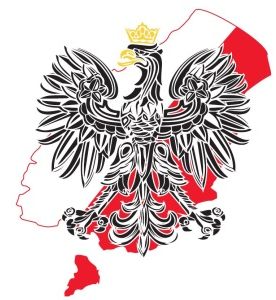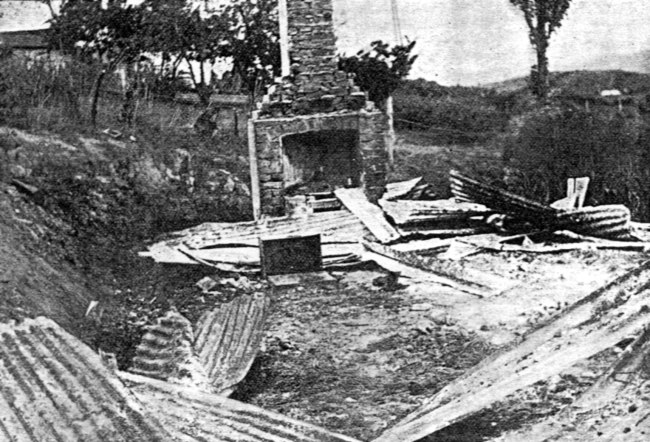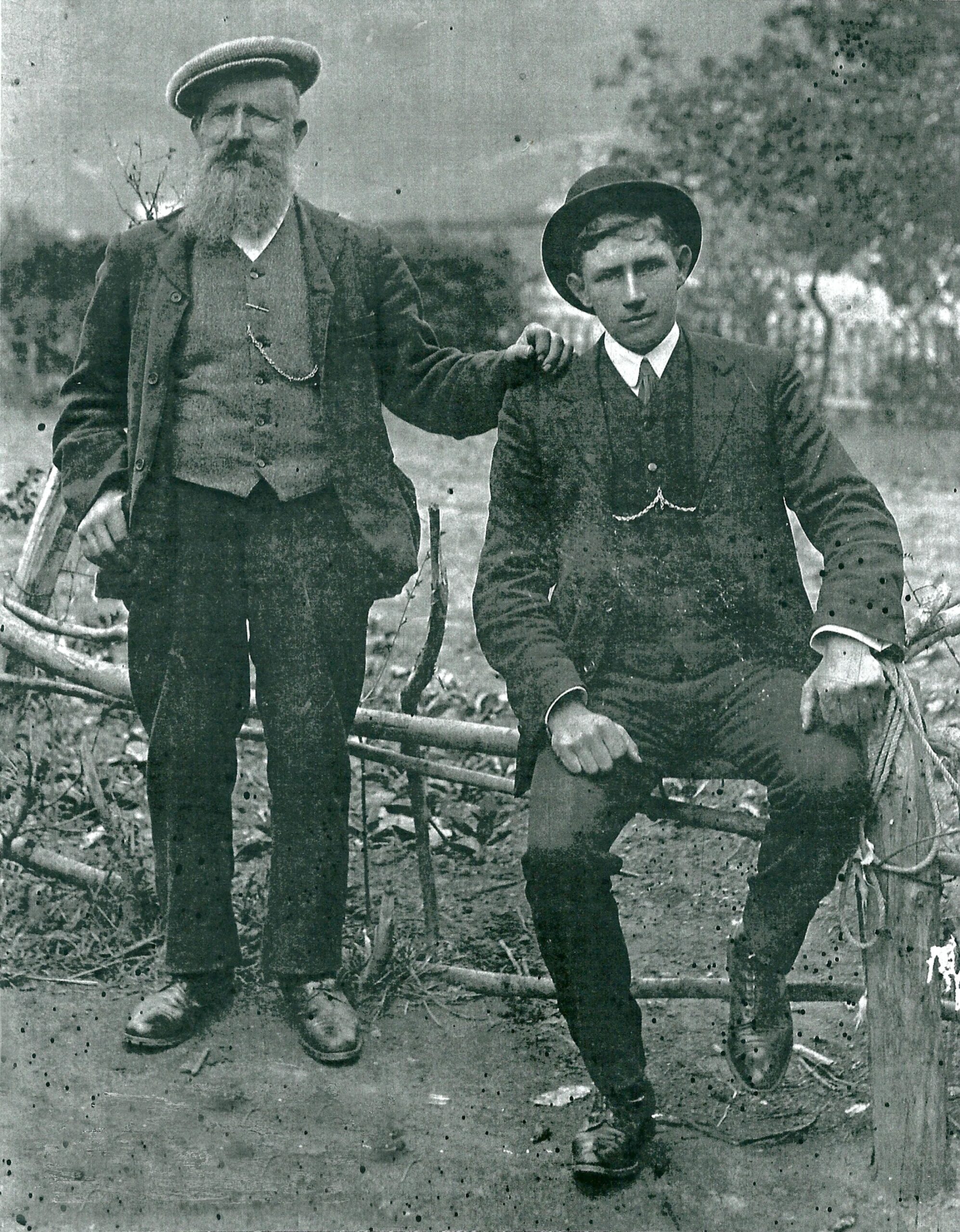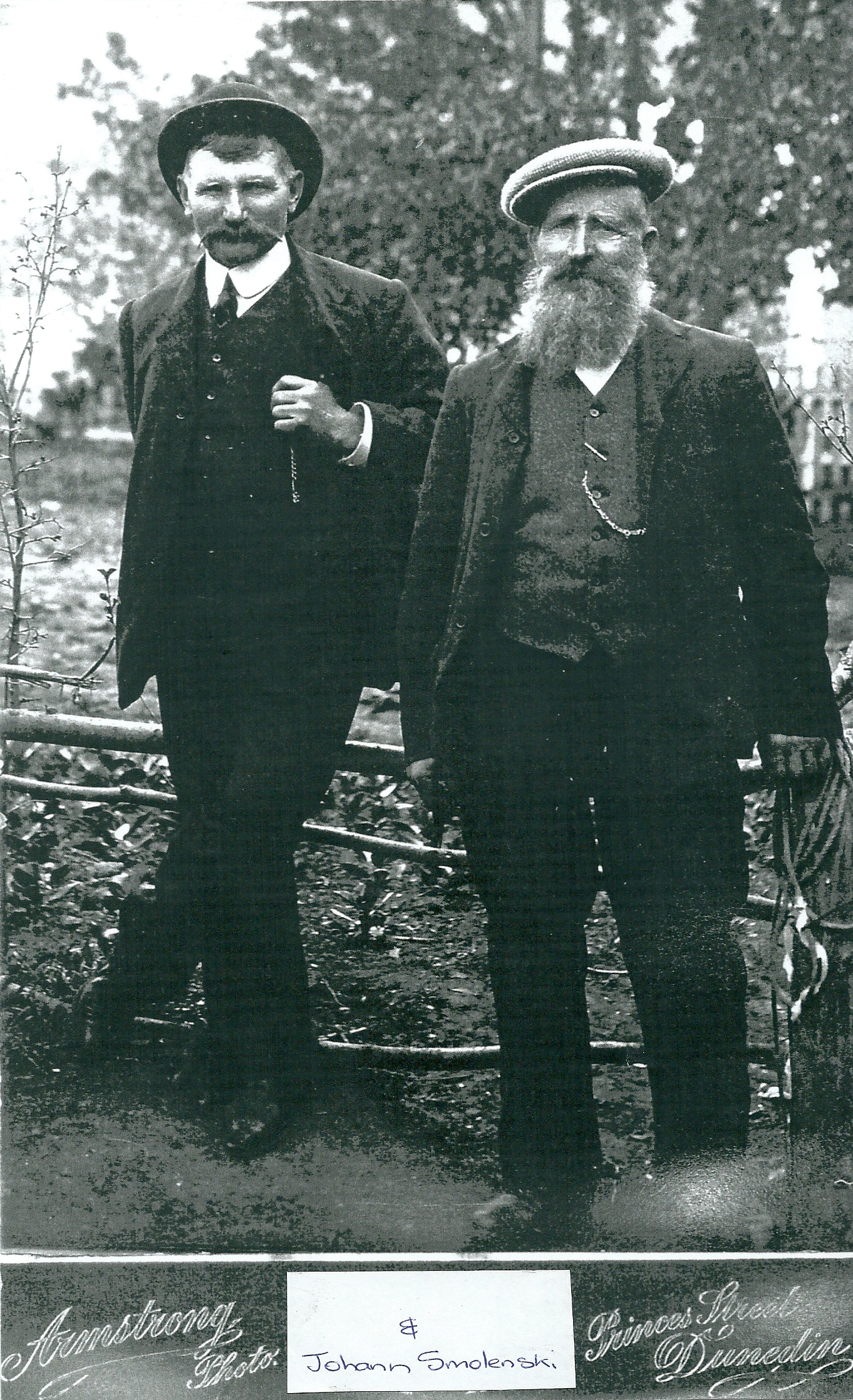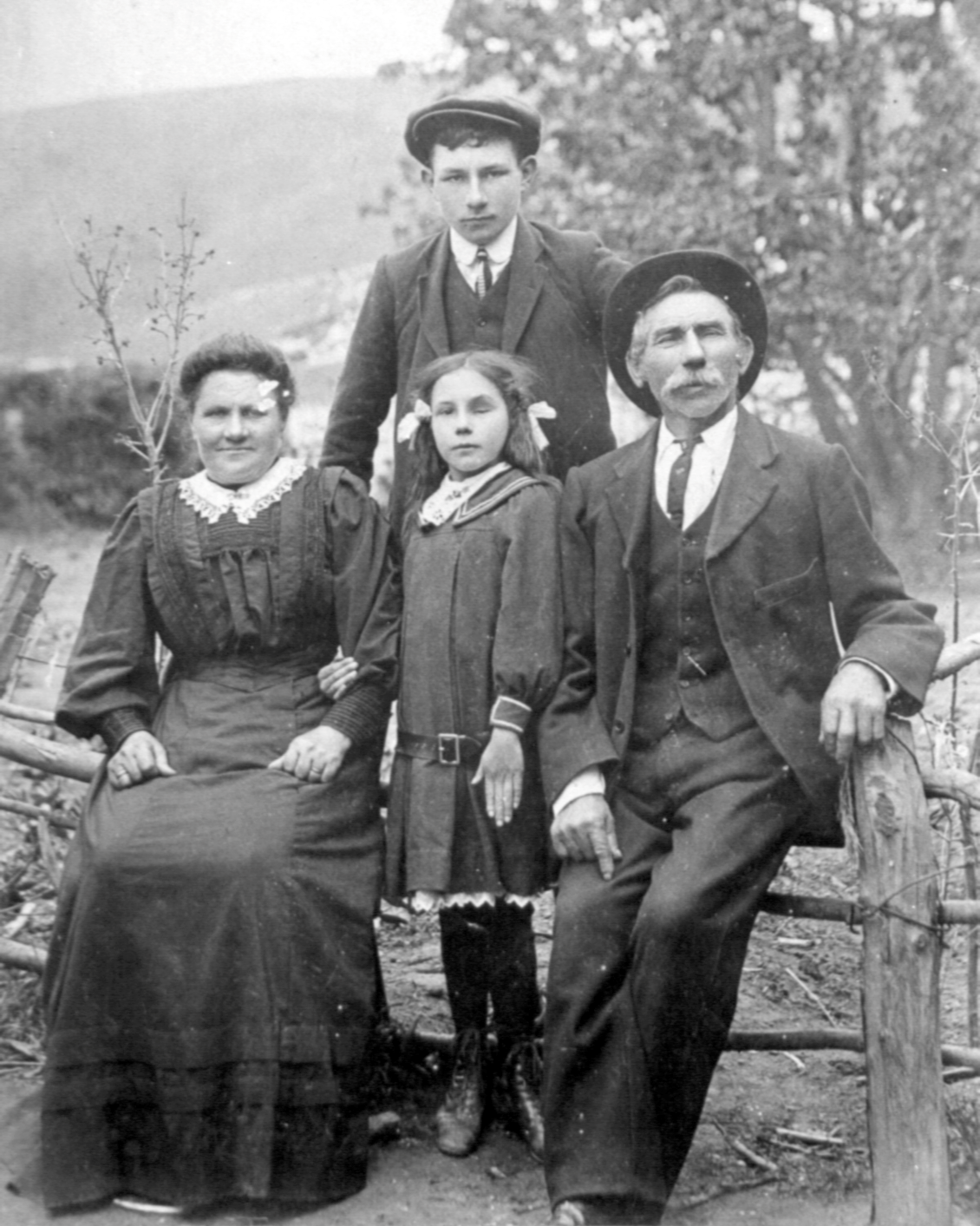Polish Settlers at Allanton
The summer of 1873 saw the largest contingent of Polish settlers designated to a settlement near Scroggs Creek for work on the main trunk railway, which was before long progressively creeping southward along the eastern periphery of the Taieri plain. Packed in wagons the convoy made their way via the old south road, which superimposed the original, Maori foot tracks through the Taieri. Supplied with canvass and wooden framing they eagerly constructed their temporary abodes. Among the first shipment of Poles to settle in this district where; Paul Baumgardt, Johann Bucholz, Johann Dysarsch, Joseph Gorinski, Johann Halba, Johann Hoffman, Franz Jankowski, Philip Konkel, Lorenz Kowalewski, Johann Michalski, August Orlowski, Johann Orlowski, Joseph Pedowski, August Plewa, Franz Reikowski, Franz Rogacki, August Rydszewski, Johann Schultz, Frederick Teike, Anna Walinska, Jozef Welnoski and Johann Wroblewski. The settlement was first formed on the undulating land between Scroggs Creek landing and the main road during the advancement of the riverside farms during the 1850s and 60s. By now there was a school, which occupied the old Thistle Inn, a Presbyterian church, a hotel namely the Kent run by Mr. Holland, a smithy owned by A. M. Graham, and a store.
By March 1873 saw six families relocate southward to the settlement of Waihola being suggested as a better location for wood and water.[i] Among these were: Paul Baumgardt, Johann Dysarsch, August Orlowski & August Plewa. Soon others followed, being; Johann Halba, Johann Hoffman, Franz Jankowski, Johann Orlowski, Franz Reikowski, August Rydszewski, Johann Schulz, Frederick Tikey (only to return to Greytown for a short period) and Joseph Welnoski.
By late 1873 the works were in full progress, and the bridges were in due course of erection across the Taieri River at various places.[ii] Prior to the tracks being laid the area had to be drained which saw the men folk work in waist deep water. For the most part, this year saw the earthwork near to completion with additional labour incurred in fencing along the line of rail. Much of the material for building the railway was supplied by nearby woodland or brought up the river by shipment and the ballast being supplied by nearby quarries. An iron engine shed was erected at Scrogg’ Creek late 1873 with a locomotive fitted with a view to commence ballasting using material from Scrogg’s Hill. By early 1874, one could see sleepers and rails placed in convenient positions along the line ready for placement.[iii]
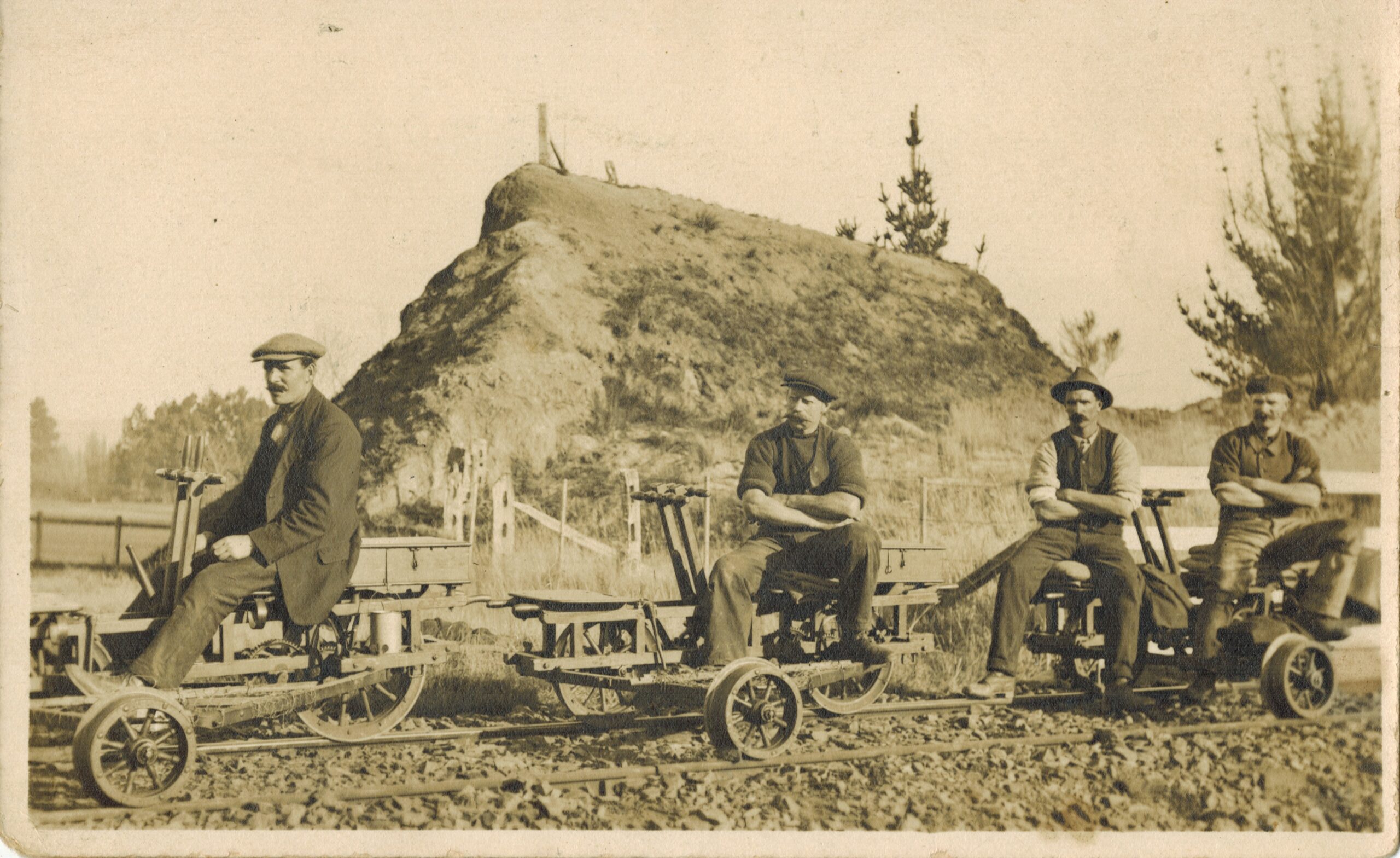
Polish Railway workers near Allanton, courtesy of Gwen Holleyman, a great granddaughter of Joseph Pedofsky
In January of 1874, saw a tragic incident include a Polish settler, Frederick Trapski, who migrated to New Zealand from the district of Danzig, West Prussia, during the 1860’s and was well known to the area for the past twelve years. Enclosed is a report of the incident;
“Steadman’s four-horse Waihola coach, driven by T. Aitken, met with an accident on Monday morning. When passing Lookout Point, the pole broke short, and the coach upset, the horses bolting with the front carriage, and dragging the driver for a short distance with them. He escaped, however, without injury, but some of the passengers—of whom there were a good number—received nasty bruises from the metal. William Mulligan had one of his wrists sprained; and Fred Trapske, a German, was conveyed to the hospital, being severely bruised, but having no bones broken. The other passengers were forwarded to Dunedin by a Caversham bus. – “The Otago Witness”, 10 January 1874
Around September Frederick Trapski was admitted to the Dunedin Asylum. Although having several weeks of hospitalisation, Frederick never properly recovered the shock, and his ill health with the inability to support his family caused great distress, which resulted in his insanity. Many locals of the area endeavoured to raise a contribution to support his wife and four children. He unfortunately died some three weeks later at the asylum.[iv]
“The newly established township of Greytown (East Taieri) has, within the past few months, made rapid strides, and bids fair to soon outgrow its elder brother of Riccarton. A goodly number of small selectors have settled down in this locality, and the buildings being erected show that they intend making a permanent stay. A few of the new inhabitants consist of German immigrants lately imported, and, to all appearance, they seem a most desirable class. The bridge at this township, crossing the Taieri River, is about to be commenced, the contractor only waiting the arrival of the imported timber to commence operations. A new school has within the last two months been erected, and is a very creditable building. The Government granted £487 towards the contract for school and teachers residence, and the total cost has been £537—£50 being raised by the inhabitants of the district. The school room is very commodious considering the size of the township; it measures 30ft x 20ft, and will comfortably accommodate 100 scholars. Under Mr. Macandrew the school is progressing very favourably, so children being entered on the roll. Should the present average attendance continue this school will be entitled to be ranked as a main school. The new teachers residence has been designed to afford every convenience, and is a neat four roomed cottage, with pantry and scullery, and stands in the midst of a glebe of some three acres. The Government are about to erect in this vicinity three immigrants cottages, similar to those, proposed at Waihola; each cottage is to consist of three rooms and, with an acre of ground, is to be leased to new arrivals at a small rental, with right to purchase. Noticing the rapid progress of Greytown, we may expect the holders of land in Riccarton will be stir themselves and sell in sections, thus giving an impetus to this township, which, from its now progressive policy, it would seem to have some need of.“ The Bruce Herald, 22 May 1874
By late 1874-75 saw the small district swell once again with Polish families being of; Johann Switalla, Anton Piernicki, Johann Klaas and Anton Kowalewski. Soon it became necessary for the Poles to choose a common abiding place as their railway contract was drawing to a close, and so they developed upon an area close to the old settlement site between the main road and river where they established a more permanent structure of sod or wood. Some left to follow the railway construction to the south, others went to pursue other prospects. Johann Bucholz left for the Waikaka Valley, Philip Konkel left for the district of Pine Hill, Johan Michalski left to settle in Mosgiel Junction, Anton Piernicki left to farm in the district of Pine Hill, and Frank Rogacki moved to Mosgiel (later moving to the Polish settlement of Marshlands at Christchurch).
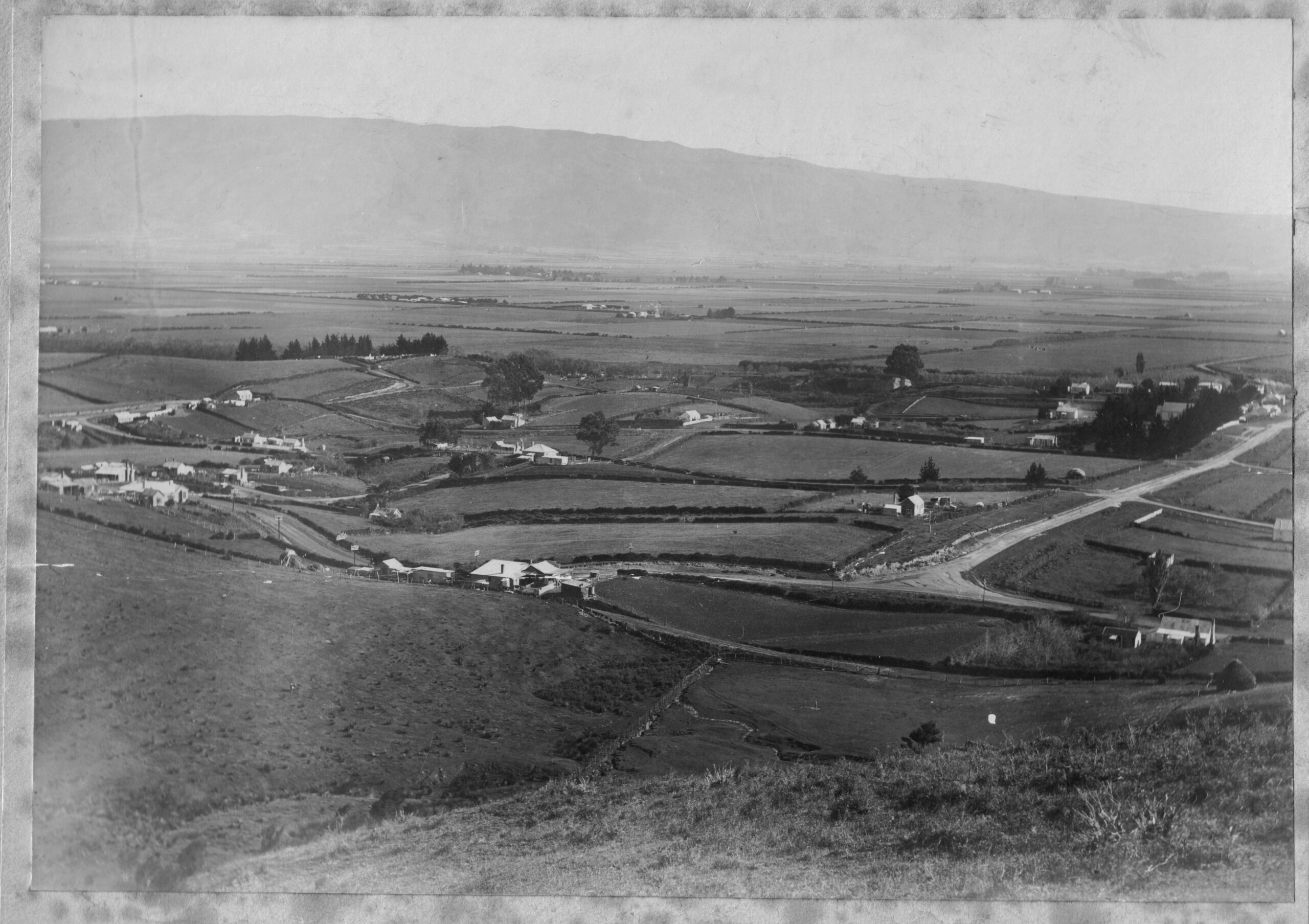
Birdseye view of Allanton in 1908, courtesy of the Otago Witness
In July of 1875, Mr. Fowler opened his blacksmith for business and during the same year the Railway Bridge across the Taieri was completed. By this time a Railway Siding was placed in the settlement and given the official name of Greytown, in honour of Sir George Grey. It was not until ten years later that Greytown had finally risen to the status of a Town District. By 1876 the settlement saw the erection of a lean-to for the multiple purpose of Bank of New Zealand, post office and general store.[v] Incidentally the Post Office was moved from the store to the Greytown Railway Station on the 16th of November 1884 until 1913. From the Wises NZ Directory 1875-76, the locals of Greytown included Joseph Anderson, J. Blackmore (Kent Hotel), Richard Burrows (Blacksmith), Thomas Hollands, Alexander Johnstone, Joseph Johnston, James McHarry, W. Macandrew (Teacher), William Douglas Milligan, Allan Roxburgh, W. Roxburgh (Bootmaker) and James Wilkie (Store). It is interesting to note that Poles and non-Poles in the district integrated well together giving a helping hand wherever needed.[vi]
“Waste Lands Boards. The regular weekly meeting of the above Board was held on Wednesday Present — Messrs A. C. Strode (in the chair), H. Bastings, Butterworth, and Clark. The minutes of the previous meeting were read and confirmed. GREYTOWN. Messrs F. Rogatsky, P. Jacob Kankel, and John Wrobloskie, with three other Germans, applied to purchase areas held by them in the township of Greytown at L 3 per section, viz.; Section 13, block XII., sections 17 and 18, block XII., and having occupied and built upon the land by authority of the Government. Mr Henry Houghton, German Consul, appeared on behalf of the applicants. The Chairman pointed out that the Board had no power to sell land under the circumstances, one of the clauses providing that the consent of the Superintendent and Provincial Council must be first obtained. Mr Bastings said he was going to the Assembly next week, and he would have a short Bill brought in to meet the case. It was resolved:—” That inasmuch as the 29th section of the Waste Lands Act, 1872, makes it imperative that the Board, before taking any action in this matter, should have the approval of the Superintendent and Provincial Council first obtained, the applicants be recommended under all the circumstances to petition the House of Representatives now in Session.” Otago Witness, 19 August 1876, p 10
During the 1880’s saw a further influx of Polish migrants intending to permanently settle in the district, being; Franz Chajewski (Waihola), Jacob Gdanitz (Dunedin), Martin Grenz (Waihola), Joseph Kreft (Dunedin) and Johan Smolinski (Waihola),
As occupants, the Poles, after the close of the contract with the railways, found employment on “Hopehill” and surrounding farms and cultivated their own smallholdings to some purpose. The first of their homes were made of daub and wattle (large blocks of a mixture of clay & straw or rushes dried in the sun). Each had two rooms to start with, a big open fire in a clay chimney and clay floors kept very clean. Windows were very small as glass had to be imported and was expensive. Most of the early houses had thatched roofs but later were replaced with corrugated iron. Eventually good wooden homes were built, small but seeming to house large families adequately Baking in camp ovens was the only method of cooking. Water was boiled in black cast iron kettles or billies, and washing was done outdoors over open fires in four gallon kerosene tins. Water had to be carried from wells or the river, there being at least five wells in strategic parts of the township. Opposite the pump at Caernavon Street was the local washing hole which was naturally carved out of the landscape. Before the road was formed the pump was accessible by a rough track. A set of dug out steps lead down to the washing hole and large stones. A large tree also use to dominate the site which would have provided much needed shelter from the sweltering sun. Here the woman would bring their washing to be scrubbed and an opportunity to catch up with the neighbours. When roofs were replaced with corrugated iron water could then be collected and stored in iron tanks. Furniture was mostly home made of rough sawn timber and was very strong. They had cool-stores, storing apples from season to season; they made their own cheese, butter, and bottled drinks and made such beautiful Polish food. All families owned at least one pig, a cow and a couple or more beehives, with their display of bright gardens to complete the setting. As quoted from Shaw & Farrants’“The Taieri Plain” (1949),
They created an atmosphere reminiscent of the fairy tales and sweet honey-cakes of Poland’s happier days.
On the 28th of July 1869, William Macandrew opened his private school in Simson’s stone building, the old “Thistle Inn”. By October 1870, the number of pupils had so increased that the school was taken over by the Otago Education board. By 1874 a new school of one room was built on the site of the present school. Later because of an increase in roll from the surrounding districts a second classroom was added to the building about 1895. By observing the school roll books, the first Poles to register were not until 1877-78 when the main railway was well in operation and time was seen to establish their own holdings to some extent. These properties acquired either through land grants on deferred payments or as they could afford it were on ¼ acre sections with extra land acquired for grazing their cows or for the planting of vegetables.[vii] Both rooms were of reasonable size as to accommodate some thirty pupils in each, entry being gained through a porch where coats, hats & bags were stored. The floor at the front of each room was about twelve feet wide then rising in tiers up to six or seven steps until the highest level was reached some four feet above the classroom floor. As a result of this seating arrangement every pupil was in full view of the teacher. The windows were set high in the walls, and were frosted over to prevent anyone trying to peep out. On these walls were displayed a photo of the monarch, a Union Jack, map of the world and a copy of the Ten Commandments. In the infant room there were no wall blackboards, but hung were several bead frames on which were taught to count and learn tables. The other classroom catered for the Standard 3 to 6’s. The playground was divided into two parts by a high wooden fence at the end of which were two large play sheds where you could shelter in wet weather.
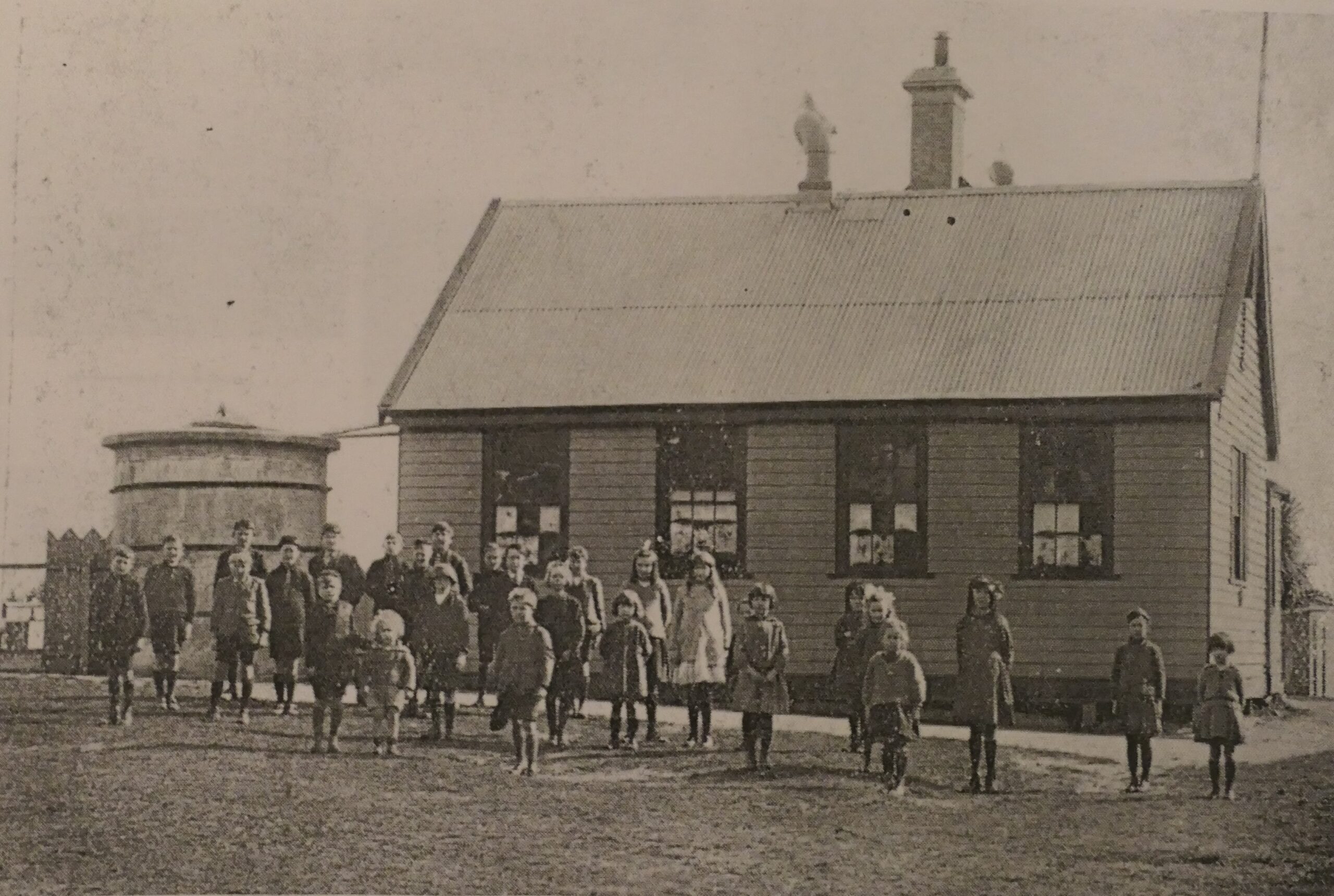
The Allanton School And Pupils, South Taieri, courtesy of Otago Witness, 17 October 1922, p 38
The following are some excerpts from the local rag of school activities in its primary years.
“ANNUAL CONCERT- The Greytown School annual entertainment the other evening was of a novel character, and an immense improvement upon the somewhat antiquated songs and recitations which usually obtain on such occasions. There was a two-act comedy entitled “A doctor in spite of himself,” and a fairy extravaganza called “The Queen of Hearts.” Scenic effects, &c., were well got up, and the performance was highly appreciated by the audience. The idea is a capital one, and we strongly recommend other schools to attempt something in the same line when breaking up time comes round again.“ The Bruce Herald”, 21 December 1883
“THE ANNUAL concert of the Greytown public school was held on Friday evening and the promoters were rewarded by a full house. The school children contributed four items; ‘The bells’ and ‘Hark; hark; the lark, being sung in really good style. In addition to this the part song ‘Poor old Joe’ was prettily sung by Misses Christie, McKegg, and Brocket and Masters C. Reid; and a pressure on our space prevents our giving round was rendered by twelve others. Miss Stevenson, of Henley, contributed two solos, the audience insisting on an encore for her song ‘Barney take me home again’ in response to which she gave the appropriate solo ‘Barney’s answer’. Madam Ivens, Miss McKegg and Mr. Jos. Allan gave piano solos which were also much appreciated. Mr. R. Allan sang ‘The challange’ and ‘The deil’s awa wi’ the exicise man; and but for the length of the programme would have had to respond to an encore. The second part of the programme was entirely sustained by the children who performed the operetta ‘Dick Whittington’ in a very creditable style when reasonable allowance is made for the performers being children. The only fault to be found was that the voices became a little tired towards the end of the 5th act; but throughout the performance was good, the acting being intelligent, the choruses crisply taken, and the solos and recitations correctly sung as so time and tone. The principal parts were taken by Miss E. Brockett (Whittington), Miss E. McKegg (Cook), Miss Janet Irving (Alice), Masters Ralston (Fitz warren), and C. Read (Captain), divided the honours of the performances, Misses Brocket and Irving in particular pleasing the audience by their correct singing and intelligent acting of very difficult parts. Master Reid and Ralston also sang their parts in good style and contributed materially to the success of the evening. Miss E. McKegg is entitled to special notice for sinking her identity so completely in her part of the cook, whom she made amusing, and at the same time carried out the idea of the cross-grained, ill-tempered servant, who made poor Dick’s life a burden to him. Even the cat also gave up all thoughts of mice for once, and submitted to become as it was, the exponent of the realistic part of the play. The performance came as a surprise to some, and great credit is due to the children for their intelligent interpretation, and to Mr. Ivens, who must have had the children very carefully trained in music before they could have performed so difficult a piece in the manner they did. Among the other children, we noticed with pleasure the performances, though in small parts, of Misses Christie, Bruce, Fisher, List, Wrobflensky, and Wilson, and Masters Christie, Irving Schruffler, and Ford, and others whose names we could not ascertain. The performances concluded with the customary vote of thanks. The dance which followed was well attended and kept up till an early hour. We are glad to hear that the concert was also a success financially. -“The Taieri Advocate”, 24 December 1890.
The following is an amusing article concerning the town’s namesake;
“THE LIBRARY—The Greytown Hall Committee have added a large number of new books to the library. Some time back when Sir George Grey visited Greytown that gentleman promised a donation of books to the Greytown Library, as Greytown was named in his honour; but we never received them yet. I think that Sir George Grey has forgotten it.“ The Taieri Advocate”, 17 October 1885
“GREYTOWN [From our own correspondent] A meeting of the Town Board Committee was held on Monday evening, the following members being present. Messrs Irving, Brown, Holland, Scrivener, Traill and Black. The minutes of previous meeting were read and confirmed. The petition praying for a Town district was signed by 49 out of 54 people, and a valuation roll, was prepared, which will be sent to Wellington in a few days. The meeting then adjourned. “The Taieri Advocate”, 16th September 1885.
“GREYTOWN DISTRICT ELECTION The first election of Commissioners for the Grey Town Board took place yesterday, and created a considerable amount of interest. The voters rolled up to the poll in good numbers, and about six o’clock quite a crowd of people assembled at the polling-booth, anxious to hear the result of the election which Mr. A. Blair, the Returning-officer, declared to be as follows: John Black, 62; Thomas Christie, 89; Walter Hollands, 46; Thos. Hollands, 51; Joseph Johnstone, 48; Jas. List, 41; John Switalli, 50; Alfred scrivener, 52; and declared Messrs Christie, Black, Scrivener, T. Hollands, and John Switalli duly elected as the Commissioners for the first Town Board of Grey. The result was received with cheering and several of the successful candidates addressed the electors, thanking them for the honour they had conferred upon them. A vote of thanks was passed to the Returning-officer.“ The Taieri Advocate, 24 February 1886
“GREY TOWN BOARD The first meeting of the Grey Town Board was held in the Athenaeum, on Friday evening, 26th February, 1886. The following members were present. Messrs John Black, T. Christie, Thos. Hollands, A. Scrivener, and John Switali. On the motion of Cr. A. Scrivener, seconded by Cr. T. Hollands, Cr. T. Christie was voted to the chair. It was resolved on the motion of Cr. J. Black, seconded by Cr. J. Switali, that tenders be called for the clerkship to the board. The Chairman was appointed to wait on the Outram Town Board to get a copy of Bylaws, the meeting then adjourned till Friday, 5th March. “ The Taieri Advocate, 3 March 1886
“GREY TOWN BOARD The adjourned meeting of the Grey Town Board was held on Friday evening, the following Commissioners being present. Messrs T. Christie (Chairman), J. Black, T. Hollands, A. Scrivener, and J. Switali. The minutes of the previous meeting were read and confirmed. The following tenders for the office of Clerk to the Board were received: James Stevens, £8 per annum (accepted); John Williams, jun. £13; James Brown, £15. The bylaws for Greytown were read and adopted. On the motion of Cr. Black, Seconded by Cr. Switali; it was resolved that the dog tax be 5s per dog. It was declared to open a banking account with the Bank of N.Z., Mosgiel. “ The Taieri Advocate, 10 March 1886
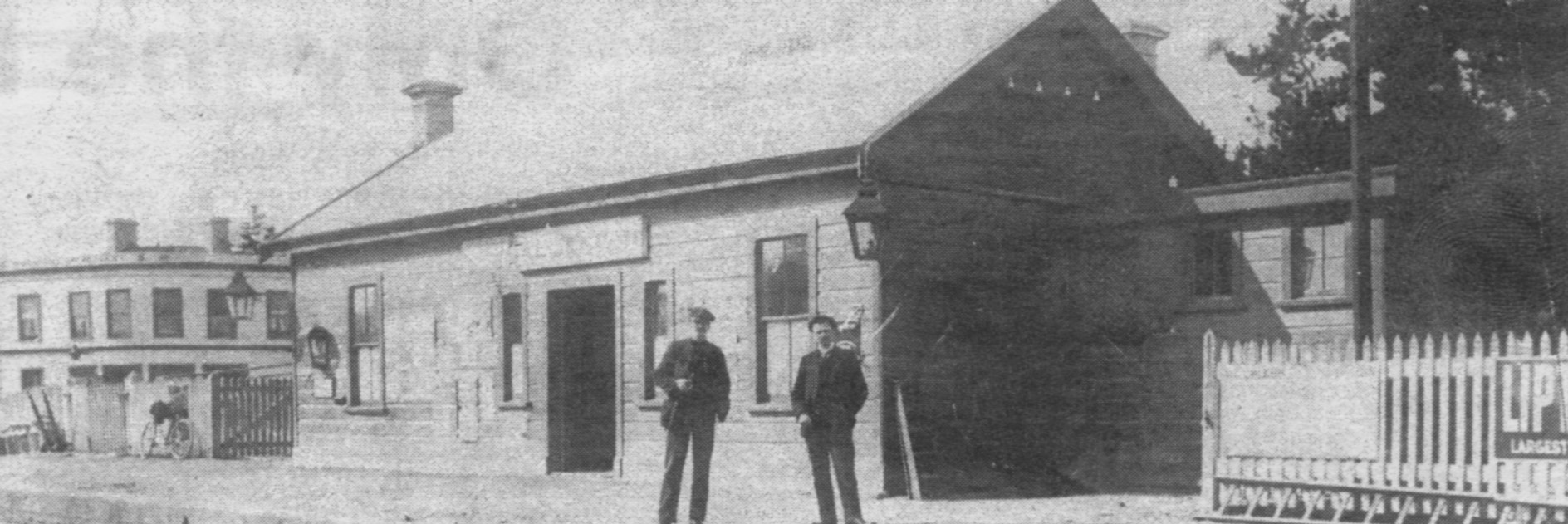
Allanton Railway Station with the Crescent Hotel on the left which was built in 1886
The following are a few humorous and not so humourous articles relating to our four legged friends.
“We have been informed that a number of Greytown residents are drowning or shooting their dogs in preference to paying the registration fee, which they complain of as being too high.” Burce Herald, 14 February 1882, p 3
“A CATTLE RAID – On Wednesday last, Greytown was the scene of a tremendous disturbance, and the inhabitants of this usually quiet village have not yet recovered their wanted serenity of mind. On the day mentioned Robinson, the County Ranger, made a terrific swoop and rounded up all the horses and cattle he could find. He drove them from the reserves and off the street lines, in fact, like a free booter of old, he “collared” all he could clap his eyes on and made a grand haul. However, he couldn’t get away with such a large mob and escape observation. The alarm was soon given and in a few minutes nearly every old woman in Greytown, armed with a broom, or a pitchfork, or a stick rushed out to rescue her favourite “crummy” from the valiant Rob. As your readers are aware there a good many foreign residents here and the German and Polish ladies just gave Robinson the length of their tongue properly. He couldn’t tell what they were saying, but he thought they were swearing at him, and all he did was hold out his right hand and say, “Give me two bob, or off goes your cow to Outram”. The money was forthcoming, and the Ranger raised about £2 by his mornings work. People are now wondering whether he had any right to remove cows from the district roads, or whether he was appointed simply for the purpose of clearing cattle off the county roads. Sometime ago the Grey Board wrote to the County Council asking whether the Ranger had power to take cattle from off the county roads. You would oblige many of your readers in this district if you would kindly let them know what answer emanated from the council. The County Clerk’s reply to the letter from the Grey Road Board ran as follows: [“I am directed to acknowledge the receipt of your letter of the 10th June and to inform you that the Ranger has been appointed to look after cattle straying on the County roads. If the different Road Boards in the County desire him to take action over the district roads they will require to make their own arrangements with him” ED. T.A.] The Taieri Advocate, 26 August 1885
“A WAIL FROM GREYTOWN Sir – Greytown was visited on Monday night by a mob of sheep, two or three thousand strong, which were allowed to wander at will through the township while the two worthy drovers were well, I’ll not say where they were. A good many of the settlers here had their small grass plots pretty well cropped, while others had to stay up all night and watch their winter cabbages. However, the two worthys were not able to collect all the sheep, as there are a few of them still running about Greytown. I see that Mr. W. D. Wilkie has two prisoners out of a thousand which were in his paddock. I believe the sheep were en route for Henley – Yours, & C., Conservator. “The Taieri Advocate”, 21st April 1886.
The concert was usually followed at some later date by the annual school picnic. On the 18th of December 1893, the Greytown Railway Station was destroyed by fire.
“GREYTOWN SCHOOL ELECTION OF COMMITTEE A MEETING of householders in the Greytown School district was held on Monday evening. Here was a small attendance, the chair being occupied by Mr. T. Fisher. The meeting was held in accordance with the Act, no committee having been elected at the annual meeting of householders for that purpose. Only five nominations were received – viz, Messrs J. Brown, D. Brocket, W. Lawrence, Joseph Kreft and J. Smolenski. These being the only nominations, the above named were declared duly elected. Mr. Joseph Brown was appointed chairman and clerk to the committee. “ The Taieri Advocate, 12 June 1895.
Remembrances of the Poles early life in Greytown would include the celebrating of Feast Days, Fast Days and Holidays (Saints Days), when honey cakes would be baked and everyone sang and danced to the music of concertinas and mouthorgans. Some played the piano while some created instruments out of a comb with paper over it, all providing a fun and exciting atmosphere. As for Easter and Christmas, houses were decorated with ferns by the children in accordance with Polish custom, all of which were observed by the parents. Sewing and lace made by the yard was common among the Polish women and young girls. Mrs. Franciska Switalli was the mid-wife, bringing nearly all the Greytown babies into the world. It was a hard life for many of the men folk as they had to work up to their knees in water a good deal of the time, and they didn’t have boots or suitable foot ware in those days. On week nights nearly all the men congregated at a “Smithy” owned by Alf Pitfield. As O’Donnell’s Hotel was opposite, tongues were loosened with the slip of the odd swear word. The men whom were nearly all big, very honest and fearless, for some, were hard drinkers (though incidentally quite unable to carry liquor). There were many fights at birth celebrations, weddings and funerals and these were a great source of anxiety to the women and children.
A good way of letting of steam was sport and the following are just a few articles on the local footy team.
“A FOOTBALL match will be played today Greytown v. West Taieri. The following will represent Greytown: Full, Ralston; three-quarters, McCutcheon, Christie, Read; halves, A. Ralston, Pitfield; forwards – Beliski, Blair, Smolenski, Knutsen, Fisher, J. Switalla… “ The Taieri Advocate, 8 June 1895
“FOOTBALL GOSSIP [By Scrum] The match Greytown v. Saddle Hill, which has been looked forward to with interest, will take place today. The game, which is sure to attract a large number of onlookers, should be fast and exciting. The Saddle Hill team are a formidable lot, while the Greytown players are no “Small potatoes”. It is hoped that there will be sufficient players left to finish the game.“ The Taieri Advocate, 5 October 1895

The Allanton Football Team includes Frank Switalli (pipe in mouth), 3rd from him is Tony Wroblenski, next to him is Frank Wroblenski, Jack Wroblenski (top-left) and Antoni Velenski (centre-front), Ca. 1890s, courtesy of Lynn Patrick
“Rugby. Allanton. Allanton Bible Class v. Outsiders, at Allanton. Allanton B.C.:T. C. Pettigrew (capt,), T. Kovalevski, J. Pedovski, J. Finne, J. Smolenski, J. Krefs, J. Beliski, D. Brocket, J. Switali, J. List. C. Young, C. Newman, T. Joyce, H. Hastier. A. Roxburgh; emergencies—J. O’Donnell,, J Dysaski, T. Kovalevski. H. Barlow.” Evening Star, 3 September 1909, p 7
The local smithies were Richard Burrows & Alfred Pitfield. They also had a wheelwright working on the premises. Their job was to service the drays that carried the farm produce. They carved new spokes to replace worn ones that had become loose in the hub of the wheel. Each wheel was fitted with an iron tyre which became worn after a number of years from the rough metal roads. It was not until the late 1920’s before the main roads were then tar sealed.
Across the bridge on the road to Outram was the sale yards. As well as a yard holding horses, cattle & sheep, it had a circular covered seating area & a rostrum for the auctioneer. The day prior to the sales, truck load after truck load of these animals were shunted onto the siding from trains arriving from the North and South. Here the animals were unloaded and driven or led across the bridge to be kept in their allotted pens overnight until the sale next day.
The first butcher was run by Walter Holland. In 1882 a fire destroyed the building and the following is an article on this. “A Butcher’s Shop at Greytown, owned by Mr. Sutherland, and occupied by Mr. Holland, was destroyed by fire early on Monday. The building was insured in the Union for £200, and its contents in the National for £100.“ The Bruce Herald, 20 January 1882
In 1897 a new butcher shop was opened by the Ralston family situated on the Main South Road with a slaughter house in a gully behind. All the stock were killed there, and there being no meat inspectors in those days. As well as delivering meat to homes in the township twice a week, the smartly painted horse drawn closed vans were used to serve customers as far south as Henley, to Outram, and the whole of the Taieri Plain, leaving at daylight and returning long after darkness in the winter. Other storekeepers of the early years were run by James Wilkie, Henry Wicks, John Williams, John Black (Post Master), Allan Roxburgh, Mr. Agnew, John Currie, & Hugh McCutcheon. The local boot maker at this time was Mr. W Roxburgh. Early bakers were Thomas Taylor & Henry Hasler. Later, situated on the Main South Road, there was Shaw’s Bakery .
The Crescent Hotel run by James O’Donell was built in 1886 and was situated across from the Railway Station. Stables were also provided at the hotel for the stabling of horses and gigs. Here farmers or travelers acquired rooms before traveling by rail to the sale yards at Burnside or shopping in the city of Dunedin. It was later used as a store until it’s demolition in 1925.
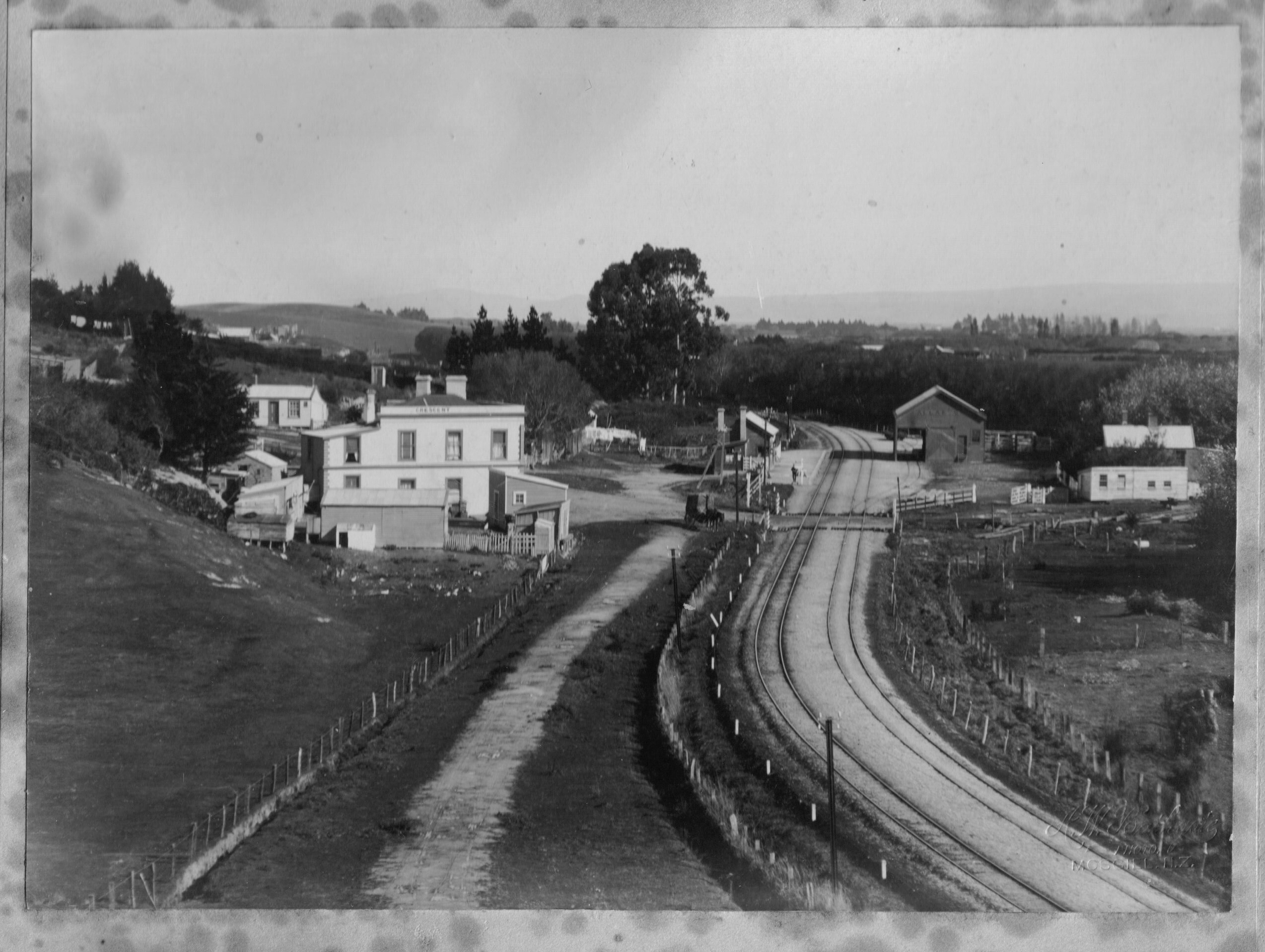
The Crescent Hotel and Allanton Railway Station, courtesy of the Otago Witness
The public Hall was erected by voluntary labour with materials purchased with money raised at fairs or from the sale of produce donated by the farmers. This was a boon to the area, with frequent dances, concerts and an occasional motion picture being screened. Of course they were silent films then, admission being sixpence for children around the year 1917. Local Balls were often held in the local hall and the Polish men had the habit of sniffing snuff, a powder formed by crushing tobacco leaf. Whenever they met they were invited to “have a sniff”, which caused sneezing and reputedly cleared the nasal passages. Apparently, at this ball, a man named Robert Turnbull walked around the hall leaving a trail of the stuff. All was well until dancing began. As the ladies in their long ball gowns swirled and turned, the snuff was disturbed and rose into the nostrils of the dancers. You can imagine the pandemonium when everyone started sneezing.
“BACHELOR’S BALL AT GREYTOWN As was anticipated a very large number of young people assembled at the Greytown ball last Friday evening, when the bachelor’s ball was held. Over 50 couples took part in the grand march. The hall was nicely decorated with fern and evergreens, and the committee must have worked hard to make the affair the brilliant success which it undoubtedly was. Mr. D. Taylor of Mosgiel, was entrusted with the catering, and was, as usual, successful in giving satisfaction. The music was provided by Messrs F. Cullen and A. Ralston, while the duties of M.C.’s were carried out by Messrs J. Blair and A. Switalla. Dancing was kept up until 4 o’clock in the morning, at which hour the company dispersed. All those that attended seemed to have enjoyed themselves thoroughly, and the ball was voted a distinct success.” The Taieri Advocate, 17 May 1893
As a community, they were all very close in regards to love for one another and most of all for the love of their religion, almost being superstitious about the later. At one time when there was an eclipse of the sun all the Polish women rushed out crying and praying, kneeling on the road sides and putting their aprons over their heads, thinking it was the end of the world. When anyone was dying a white dove would released to the sky representing the soul that left the body, indicating that it had gone to Heaven. When somebody died the Polish custom “Pusta Noc” (Empty Night) was observed by the way of all night silent prayer. Traditionally the funeral was all in black, from the wearing of black clothing, to the black coffin, hearse and horses.
There were three churches in Greytown; Catholic, Presbyterian, and Anglican, with regular weekly services, as well as Sunday School for the later. The blessing and opening of the Catholic Church “Sacred Heart” at Greytown was officiated by Bishop Moran which took place on the 19th of October 1888, being the first Polish Church in the South Island. The church was previously the first Roman Catholic Church on the Taieri located at Riccarton, which was opened on the 18th of February 1871. To help cover costs of re-erection a concert at Greytown was given in the Athenaeum Hall, on Friday, April the 20th, 1888.
The following is a report of the mass which was held on the 14th of October, 1888:
“GREYTOWN ROMAN CATHOLIC CHURCH The church recently erected at Greytown was opened last Sunday forenoon by the Most Rev. Dr Moran. High mass was celebrated by the Bishop, Father O’Neil being deacon; and Father Lynch, sub deacon. There was a large attendance, the building being found insufficient to accommodate all who had put in an appearance. The greater part of the congregation is composed of Polish Catholics, and during the sermon the Bishop appropriately referred to the struggles which Poland had been made in the past in the cause of their religion. In his introductory remarks, His Lordship said that he had come to dedicate the church, with all the ceremony they could command under the circumstances. It has been dedicated to Almighty God as the Church of the Sacred Heart of Jesus. He congratulated them on the erection of the building, which was alike creditable to them and to their pastor. It supplied a long-felt want, and he trusted it would be the means of great spiritual advancement. The majority of people who would worship in this church belonged to the Polish nation, who held a conspicuous place in history as a nation, which existed no longer – that was, it was no longer known in its political capacity. They were a great Catholic people: full of faith; full of piety; practicing their holy religion, and making for it the very greatest sacrifices that people could make. He then dwelt upon the way in which the Polish people, throughout all their persecution had adhered to the Roman Catholic faith; and said that he had no doubt that a great and good day was in store for Poland; he hoped that it would be so and that it would become once more a great Roman Catholic nation. Europe was indebted to the Polish nation for stemming the Mohammedan invasion which had threatened to over-run it. Something was in store for a people who had been so faithful and so brave and who had made so many sacrifices for God and their church. He trusted that they, representatives of that illustrious nation, would never prove themselves to be unworthy of the history of the race to which they belonged. He trusted that the Poles here would give good examples to their fellow Catholics. He hoped that the children would be gathered together in the church every Sunday, and that some of the devoted men of the congregation would come and teach them the catechism – the great truths of their holy religion. He prayed that Almighty God would bless this church and bless the congregation which would worship it. The musical portion of the ceremony was provided by the Mosgiel Roman Catholic Choir, Madam Ivens presiding at the harmonium. Visitors were present from Tokomairiro, Kuri Bush, Mosgiel and other districts. The collection amounted to the handsome sum of £75. “ The Taieri Advocate”, 17 October 1888.
In the year 1895 the small town of Greytown was about to have a name change, not to be mistaken for Greytown in the Wairarapa, North Island. The Taieri County Council decided that the name should be changed to Allanton in memory of Mr. James Allan who in 1848 was a pioneer settler on the Taieri Plains and owner of “Hopehill”. Mr. Allan was well respected amongst the Polish settlers, of whom he found further employment for, after their contract on the railway was completed.
“A NEW NAME FOR GREYTOWN ALREADY half a dozen names have been suggested to the Grey Town Board as suitable substitutes for the present name, which will henceforth be borne only by the Northern township. The names suggested are: Waipotaka, Taieriville, Seddon, Greyville, Roseberry and Gladstone. The names submitted show that the residents are inclined to a name that savours of politics, but the first mentioned name – which is the Maori name that the district bore in the early days – is we think, the most appropriate. Waipotaka sounds well and it is probable that the Town Board will select this name at its next meeting. But while referring to this matter we may state that there are those who think that there is no necessity to change the name, as the proper name of the district was Grey and not Greytown, and as the first mentioned name is not that borne by the Northern town there is no clashing of names. We do not know whether that would get over the matter, but the point has been raised. The meaning of the word Waipotaka has not yet been discovered but it has been ascertained beyond a doubt that this was the name that the place bore about 1860. “ The Taieri Advocate”, 30 March 1895.

Looking towards Allanton from Hope Hill, courtesy of the Hocken Library
“THE NEW NAME FOR GREYTOWN AT yesterdays meeting of the County Council a letter was received for the Government in which it stated that as there was another place of the same name as Greytown or one similar to it in the colony the County Council were asked to submit to His Excellency a new name to be substituted for that of Greytown. In making a selection it was suggested that, if possible, a Maori name should be chosen. The question was asked whether the County Council had the power? Cr. Snow said it was the superior local body, and had merely been asked to make a suggestion. He suggested that the names of Allanville, Allandale, or Allanton should be substituted. It would be a suitable compliment to Mr. Allan, who at one time had employed half the residents of Greytown for many a year. At Cr. Roberts suggestion it was decided to suggest the substitution of the name Allanton. The Grey Town Board met on Thursday evening, and discussed the matter of the change of name. They came to the conclusion that it would be unnecessary to make any change. As the name of the district is “Grey”, not “Greytown” they are of opinion there need be no confusion of address between the local district and the district in the North Island. We are sorry that an appropriate Maori name has not been selected, as Grey is a poor-sounding name compared with the Maori names.“ The Taieri Advocate, 6 April 1895
“Changing the Name of Greytown (Otago). GLASGOW, Governor. A PROCLAMATION. WHEREAS there are now existing two places in the Colony of New Zealand bearing the same name, that is to say, the Borough of Greytown, in the County of Wairarapa South, and the Township of Greytown, in the Taieri County, the last-names being the more recent in date of existance: And whereas, under the fourth section of “The Designation of Districts Act, 1894,” I lately required the County Council of Taieri County, being the local authority having jurisdiction in that behalf, to submit a new name for such township for my approval, as mentioned in the said section: And whereas the said Council hath accordingly submitted to me the name of “Allanton” in lieu of the existing name of “Greytown”: Now, therefore, in pursuance and exercise of the powers and authorities conferred on me by sections two and four of “The Designation of Districts Act, 1894” and of all other powers and authorities enabling me in this behalf, I, David, Earl of Glasgow, the Governor of the Colony of New Zealand, do hereby proclaim and declare that the name of the Township of Greytown, in the Taieri County, shall be and the same is hereby altered to “Allanton”, and do assign the last-mentioned name to such township accordingly, and also do hereby proclaim and declare that this Proclamation shall take effect on and after the first day of December, one thousand eight hundred and ninety-five. Given under the hand of His Excellency the Right Honourable David, Earl of Glasgow; Knight Grand Cross of the Most Distinguished Order of Saint Michael and Saint George; Governor and Commander-in-Chief in and over Her Majesty’s Colony of New Zealand and its Dependencies; and issued under the Seal of the said Colony, at the Government House, at Wellington, this twenty-second day of May, in the year of our Lord one thousand eight hundred and ninety-five. A. J. CADMAN, For Minister of Lands. GOD SAVE THE QUEEN!”
Early 1902, Allanton made household news throughout New Zealand, when an assumed murder took place in the usually peaceful neighbourhood. On March the 26th, a fire demolished the cottage of one, Annie Sinnott, the widow of a wealthy farmer. When rescued, little remained of her body, with the exposure of a carving fork struck through her heart.
“TELEGRAPHIC. FROM OUR OWN CORRESPONDENT. Dunedin, this day… At the inquest at Allanton on Mrs Sinnott, held yesterday, the doctors said the blow through the heart must have been given before death. The evidence showed that deceased and the man Sweeny had lived together, that both drank and frequently quarrelled. Antoni Kovaleski, a butcher, said that on the night of the fire, he saw Sweeney sitting in front of deceased’s bedroom window; he was calling out “Annie let me in;” after that he heard him say “Annie you old, let me in.” He got up and sort of staggered to the door, opened it and got in. Witness next saw him at the fire. He’ told someone to go for Constable Carmody; he was crying and saying “Poor Annie” Martha Kovaleski, wife of last witness, said that on the night of she saw Sweeney sitting close to deceased’s window. He was calling out to deceased and making use of bad language. He next went inside, but witness heard no noise in the house. Rosalie Kreft said .she saw Sweeny in the early part of the evening of the fire. He was bending down looking through deceased’s and he was calling out “Annie, let me in.” He came to her house while the fire was burning—that was after the roof had fallen in. Witness said it was awful about Mrs Sinnott and he replied he had not been across the road until the fire. Witness said, “Hughie, you were;” he repeated ” I was not.” Witness said, “I saw you.” She could not make him out; he was full of sorrow and was crying. She saw blood on his face. Similar testimony was given by others. A verdict was returned of murder, but there was no evidence to show by whom it was committed. The prisoner was brought into town. He will be tried before the magistrate on a capital charge.” Lake Wakatipu Mail, 4 April 1902, p 4
Local, Hugh Sweeny, accused of her murder was acquitted and returned to Allanton a free man. Here he lived amidst the folk who had given evidence against him. Six years later he died after a lingering death from cancer. Only forty pounds of Annie were buried. The rest was scattered around the ruins of her cottage. This produced unease among some of the more superstitious residents and there were stories of her ghost appearing. Finally a priest was asked to perform a service of exorcism on the site. The holy water he sprinkled may have laid Annie’s ghost to rest, for it did not reappear again. Perhaps also the memory of what happened on the night she died was soon forgotten.
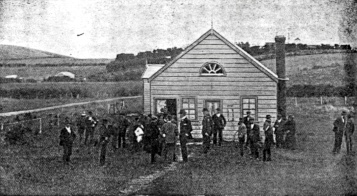
Inquest of Annie Sinnott held at Allanton in 1902
“THE ALLANTON TRAGEDY. INQUEST ON THE BODY. [From Our Special Reporter.] ALLANTON, April 3. The inquest on the body of Annie Sinnott, whose charred remains were found in the recent fire at Allanton with a carving fork, alleged to have been thrust in her heart, was resumed at Allanton this morning before Coroner Graham and a jury of six. Mr J. F. M. Fraser appeared for the police, and Mr A. C. Hanlon for H. Sweeney, the accused person. Inspector O’Brien was also present.
Dr Blomfield deposed that he had examined the corpse of deceased on Good Friday with Dr Cattan, of Outram. The room in which the remains were was 11ft by 11ft. The doctor then described the places in which he had found the various portions of the bones of the body. He examined the charred remains, which consisted of trunk with the front wall burnt away; both legs were burnt off; the right arm was missing, and the left arm below the elbow. Parts of the skull wore also missing, and a good deal of the face was burnt away. the lungs and heart were shrivelled, and in the heart was embedded one prong of a two pronged fork, the other prong being broken. The prong had entered at the upper part of the right ventricle, and pierced this at the point appearing near the apex of the left ventricle. The blow could have been delivered during life, and the result would probably be a quick death. In many cases of wounds of the heart the person might survive some hours, or death might be instantaneous. The handle of the fork was lying obliquely, and would point to the middle of the right collar-bone. Portion of the fork, which was embedded in the heart, measured 2¼in. The liver was a large dried mass, and on the outer side of this was some soil.- Most of the bowels had been burnt away, but portion of the large intestine which remained was very red in color. The right cavity of the heart contained clotted blood, and the left was empty. To Mr Hanlon: The point of the fork protruded from the heart. You could just see the point. No part of the broken prong entered the heart. The heart, was very shrivelled. It, had shrunk to about one half its size. Dr Catton extracted the fork whole. The entry of the fork into the heart was clean. It was not a jagged cut. To Mr Graham: If the fork had been inserted after burning it would have been probably a more jagged hole, and would have had the effect of tearing, the heart from its attachment.
Dr Cattan, of Outram, agreed with the evidence of the last witness. He extracted the fork, which was firmly embedded and required a considerable pull to bring it out. The appearances he noticed were consistent with the theory that the woman was stabbed with the fork, thus causing her death. That was certainly the most probable deduction. Mr Hanlon had no questions to ask.
John Currie, storekeeper, Allanton, said that he knew deceased, who lived about 50yds from his store, on the Main South road. He also knew Hugh Sweeney. Deceased was a woman of intemperate habits. He last saw her at ten o’clock on the night before the fire. She came to his store for a packet of candles. She was then slightly the worse of drink. He had known her for four years. Sometimes she lived by herself, and sometimes Sweeney lived with her. On going to his door at 8.30 p.m. on the 26th of March he saw a bright light in the direction of deceased’s house. Two men ran at once to the fire, and witness followed with a bucket of water. The flames were coming out, of the bedroom window and door. The bedroom window was open. The bulk of the fire appeared to lie in the bedroom. Witness could not get into the house. He afterwards saw the remains of deceased in the kitchen with a sheet of roofing iron over it. The body from the breast to the head was uncovered. The body was lying on its back, with the head towards the fireplace. He recognised some of the clothing taken out from under the body as that of deceased’s. He sold it to her. Witness was in the habit of drawing Mrs Sinnott’s income—£2 a month—from the Perpetual Trustees. Witness saw Sweeney about five minutes before the fire broke out. He was going in the direction of his home, and had a boy with him. He turned up at the five after witness got there. He seemed to be slightly the worse of drink. Speaking to the crowd, he said: “Try and get the old girl out of the fire.” Sweeney spoke to a man named Finnie, and accused him of setting fire to the place. To Mr Hanlon: Deceased was of medium build. She was of good figure, and had been a fine-looking woman. From what he found, he would say that she had been wearing corsets.
Henry Haslen, residing next door to deceased, said that he had known her for five years. Sometimes she lived with Sweeney, and sometimes he heard what he took to be quarrels between them. He last saw deceased on the 24th March, when she was sober. He passed Mrs Sinnott’s home at about eight o’clock on the night of the fire. He heard her voice. Ho took it to be that she was in anger and excited. He heard no other voices. Christie and witness were first on the scene of the fire. He found flames and smoke coming out of the bedroom window which was open from the bottom 4in or 5in. The door was closed. He tried to get in, but smoke and heat drove him back. He then went down on his knees, but could hear nothing. Later on he heard a dog crying out inside. He saw Sweeney at the fire. He heard loud talking in deceased’s house after he had gone to bed on the night before the fire. To Mr Hanlon: He could not hear what deceased was saying. She seemed to be annoyed and agitated.
David Finnie said he had known deceased for the last eight years. During that time she had sometimes lived alone and sometimes Sweeney resided with her. Witness knew Sweeney quite well. The latter had been living in a hut opposite the deceased s house during the week preceding the fire. On the evening of the fire witness was going to the Presbyterian Church at 6.15, and was opposite the Catholic chapel when he met Sweeney, who said “Good evening, Dave.” Sweeney said: “You in a hurry,” and witness replied: “I am behind time.” Sweeney was then going in the direction of his hut. Witness was at church about an hour, and then went home. He was standing at his door when Sweeney came up from the direction of the deceased’s house. He was under the influence of drink. Sweeney had a conversation with witness on March 16, when he accused him of speaking about his character. Sweeney struck him, and said that Mrs Sinnott was keeping him (witness) in food. Sweeney and Mrs Sinnott had occasional quarrels, but witness had not seen any blows exchanged. Witness was not the cause of the quarrelling. Sweeney had often spoken to witness about the deceased, accusing him (Finnie) of being down at her place. Witness was at the fire, and Sweeney said to him: “You old – , it was you that set fire to it.” Witness replied; “No.”
Antoni Veienski, butcher at Allanton, said that on the night of the fire he saw Sweeney sitting in front of the deceased s bedroom window. He was calling out “Annie, let me in.” After that he heard him say: “ Annie, you old – , let me in.” Ho got up, sort of staggered to the door, opened it, and got in. Witness next saw him at the fire. He told someone to go for Constable Carmody. He was crying and saying “Poor Annie.”
Martha Velenski, wife of the last witness, said that at seven o’clock on the night of the fire she saw Sweeney sitting close to the deceased’s window. He was calling out to the deceased and making use of bad language. He next went inside, but witness heard no noise in the house. To Mr Hanlon: She did not know whether Mrs Sinnott was in at the time or not.
Rosalia Kreft said she saw Sweeney in the early part of the evening of the fire. He was bending down looking through deceased’s bedroom window. He was calling out “Annie, let me in.” He came to her house while the fire was burning. That was after the roof had fallen in. Witness said it was awful about Mrs Sinnott, and he replied he had not been across the road until the fire. Witness said; “ Hughie, you were,” and he repeated: “I was not” Witness said; “I saw you.” She could not make him out; he was full of sorrow, and was crying. She saw blood on. his face. To Mr Hanlon: There was no one else about but Sweeney when he was calling out “Annie, let me in.” He went once to the window, and once to the door. There was a streak of blood on his cheek.
Joseph Kreft said sometimes Sweeney and the deceased were very friendly, at other times they quarrelled. He had been away from her for about a fortnight before the fire. He was living in a hut across the road from her. He last saw deceased on the forenoon of the 26th. She was going home. He could hardly say she was sober. He saw Sweeney between six and half-past six on the night of the fire at the door and the window of the deceased’s house. After the fire he came to witness’s house. Witness could hardly understand him; he thought he had had some drink. Witness told him he was at the house, but he denied seeing Mrs Sinnott. Witness said; “ Hughie, you were there. If it was not you, it was your ghost.” Sweeney then said: “You are a liar,” and went away. There was a streak of blood on his face” To Mr Hanlon: He could not say whether the blood was wet or dry. The Court adjourned at noon until 1.30 p.m.
Albert Brocket, laborer, stated that about 7.30 p.m.. on the day of the fire he saw Sweeney, who was somewhat under the influence of drink. He walked along with him towards the Main road. Witness’s brother passed them, and told them that Mrs Slnnott’s house was on fire. Sweeney said: “Oh, my God’ ” after he got to the fire.
Thomas Briggs Christie, farmer, said that he last saw deceased alive on the morning of the fire. She was the worse of drink. Thomas Latchford said that he gave Sweeney a shakedown some mouths ago. The latter told him that he had been turned out. He said he saw Jacob Switalla misconducting himself with the deceased. He said he took out his pocket knife, and intended to rip the man up, when the woman met him and stopped him. Witness asked him if he made that statement to the detectives on the morning after the fire. He said he did not remember, as he was drunk at the time.
Annie Latchford said she was a visitor to the deceased’s home about half-past six on the day before the fire. Sweeney was there. Mrs Sinnott brought home two bottles of beer, and Switalla came with a. bottle of whisky. They were drinking, but there was; no quarrelling.
Jacob Switalla said be arrived at Allanton from Oamaru on the 25th March. He had known the deceased for about eight years, and Sweeney for about nineteen. He called on Mrs Sinnott between eight and nine o’clock on the night of the 25th March, taking a bottle of whisky with him. Sweeney was there, and asked witness what he was doing there. They passed the evening together. Sweeney got more whisky. Deceased went to her bedroom about haif-past ten. Sweeney followed, and there was a scuffle in the room. He heard the deceased scream. He went to the door, and saw Sweeney holding her up by the arm. Witness told him to leave her alone. Sweeney replied that witness had no business interfering, and told him to clear out. Sweeney was on bad terms with witness over him going there.” Evening Star, 3 April 1902, p 4
Her remains have been widely speculated as to their whereabouts. Some suggest they were laid to rest with her husband, David Sinnott who died in 1884 at Waihola and was buried there in Catholic Block 07, Plot 09. However, there is a bare grave at the Allanton Cemetery for a Mrs. Sinnett in Catholic Block, Plot 08.
By 1905 Allanton had a Post & Telegraph office, railway station, public school, three churches, library, several private boarding houses and a first class hotel, and out of twelve trains passing, ten stopped at Allanton. Mail was handled at the railway station in the early days which also later operated a branch of the Post Office Savings Bank. Eventually the service was moved to Roxburgh’s store in when the first telephone was installed there. The advent of electricity finally had arrived in the small township of Allanton in the mid 1920’s.
Another incident that made the news around New Zealand was that of alleged attempted murder between two Polish brothers on Christmas Eve of 1921. Joseph Switalla was accused of attempting to murder his half brother Jacob Switalla with an axe. Apparently Joseph had become jealous of Jacob’s favouritism towards their mother.
“ASSAULT WITH AN AXE. ALLEGED ATTEMPTED MURDER. Supposed Jealousy Between Brother and Stepbrother. (From “Truth’s” Dunedin Rep.) News of a serious, affair that had happened at Kuri Bush, a district not far from Brighton; outside Dunedin, fetched the police to the scene, and one, Joseph Switalla, was arrested by Detectives Beer and Southgate. It appears that, while in an intoxicated condition, Joseph Switalla took up an axe and struck his step-brother, Jacob Switalla, with it on the head and shoulders. Jacob’s injuries are serious. On Saturday last accused appeared in Court. Chief Detective Bishop applied for a remand, which was granted. On Monday last Switalla was charged at the Police Court with attempting to murder his stepbrother, Jacob Switalla. It was stated by the latter that on December 24 he was lying on a couch in his stepmother’s house, at Allanton. Accused came in under the influence of liquor. The next thing witness realised, was being struck three or four blows on the head with something. As he rose he was struck on the back of the neck. He got to his feet and SAW ACCUSED WITH AN AXE. Accused later went to strike him again, but his stepmother, interfered. Witness went outside and accused followed and struck him on the head with a rail. There had been no previous ill-feeling. He thought accused was jealous because he was getting on better with his stepmother; accused’s mother. Accused was committed for trial. He reserved his defence.” New Zealand Truth, 18 February 1922, p 5
Joseph was sentenced to one year’s imprisonment with hard labour.
As time moved on, so did the Poles, moving to greener pastures. The faithful congregation resulted in a decrease in attendance and subsequent deterioration of the Church. However, in 1948, Father M. W. Woods was successful in having the building completely renovated, and the Church returned to full use. In February 1971, special celebrations to mark the centenary of the Church took place at Allanton.
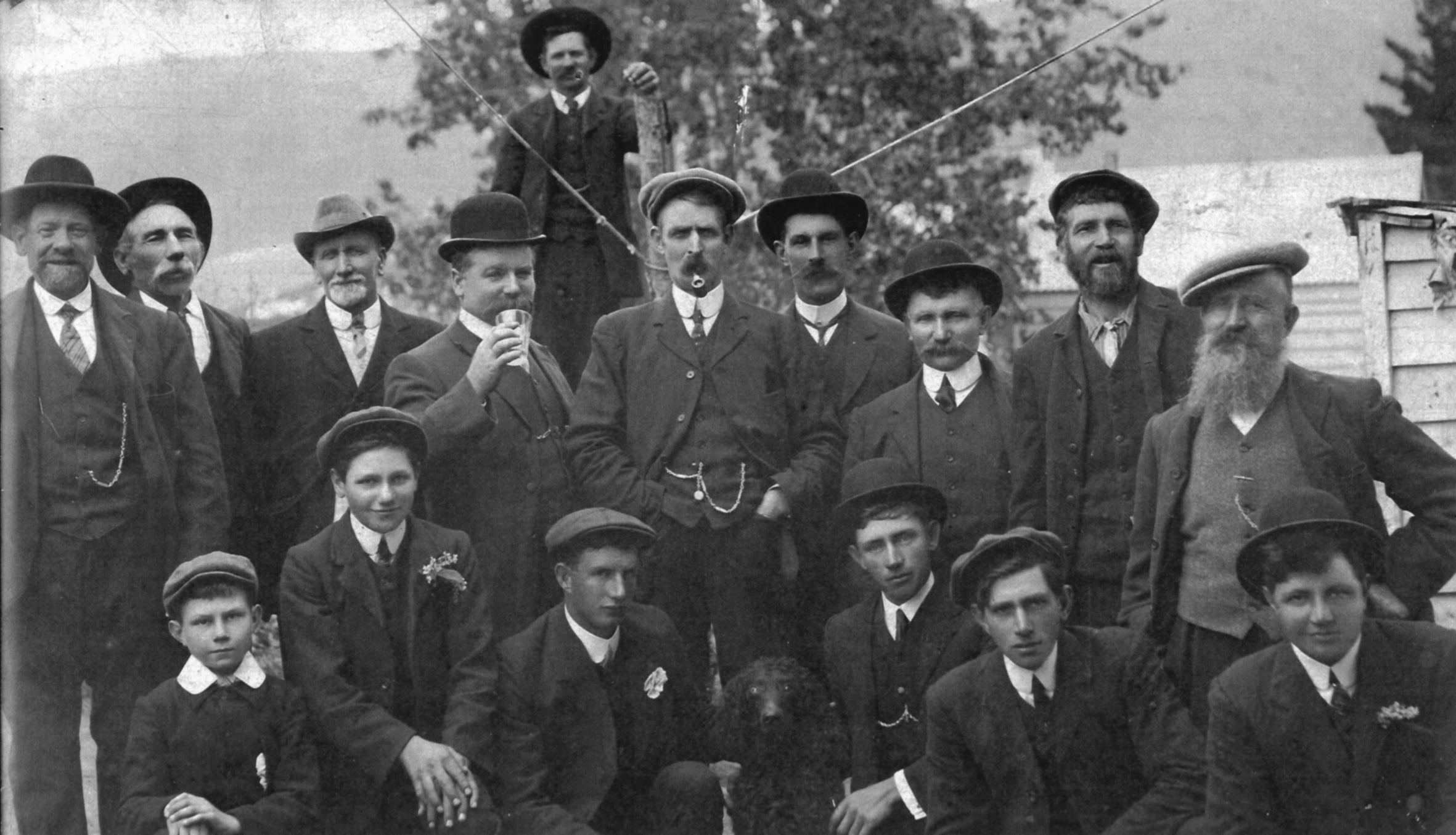
Gathering at Allanton, courtesy of Gwen Holleyman, a great granddaughter of Joseph Pedofsky.
Unsure of the event, but taken possibly at the back of the Pedofsky Cottage at Allanton. (If you know anyone in this picture just let us know.)
Back: -, Joseph Pedofsky, -, -, (standing ?), -, -, -, Switalla ?, John Smolinski.
Front: Pedofsky?, -, William Smolenski?, Dog, James Smolenski, -, -.
Taken on the same day as above; Joseph and James Smolenski – Friend and John Smolenski – Marianna, James, Veronica and Joseph Pedofsky
“POLES IN ALLANTON. PEACE AFTER PERSECUTION. MEMORIES OF THE PAST. [Written by C.R.S., for the ‘Evening Star.’] A stranger coming to the little village of Allanton, overlooking the green Taieri Plain, may wonder at the number of Polish names, and perhaps give a thought to why these names should be here. I have tried to piece together something of the history of this little settlement. It is only part of the story of a torn and wounded people.
A Polish writer says that German shipping companies made fortunes through thousands of Polish families, who could no longer endure German or Russian rule, emigrating to other lands. This writer goes on to say: “To many, besides, voluntary exile was only one of the horns of a dilemma, the other being imprisonment or death.”
A steady stream of emigrants crossed the Atlantic. The Polish colony of Chicago possesses the largest religious edifice in the United States. I have heard that when they embarked the little company of exiles who came here had intended going to America. I wonder which was the happier choice? Here they have made themselves pleasant homes with well tended fields, for the Pole is by nature a tiller and a lover of the soil. This love of the soil is revealed in the memorial to Kosciuszko, near Cracow. Peasants from every part of Poland brought loads of earile, sometimes only basketfuls, from their fields or plots, and piled up a huge mound of earile in honor of Kosciuszko. It is an ancient custom of the country to build such monuments to its heroes. While the Austrians were in possession of Cracow the Kosciuszko mound was the watch-tower of the Austrian garrison; now it is once more under the scarlet-and-white flag of Poland. I have listened to an elderly Polish lady speak of her own land. The fifty years between had not dimmed her memory of the great plains (Poland is derived from “polska,” a plain), the herds of animals and flocks of geese, the wide fields of rye and wheat (all unfenced), and the pleasant woodlands of the “fair land of Poland.”
“Oh, it was a beautiful land we left.” She went on to tell me of her experiences when she went to work for the wife of a farmer. What tears she shed while trying to master the language spoken on the Taieri Plain! “Home” was the first word she learnt to use.
To English students Polish is surprising and fascinating. Who would think of “mężczyzna” for a simple little word like man, or of connecting “dziękuję” with “thank you,” or the month, September, with “Wrzesień.” Their commonest adjective is sympathetic. “sympatyczny”; it is applied alike to, a new dress, friend, or idea. There are many words in Polish to describe the feelings—yearning, thirsting, sad, sweet contemplation, imagination. Polish imagination finds its supreme expression in the music of Chopin and the poetry of Miekiewiez. Otto Von Bismarck was able to crush Denmark, Austria-Hungary, and France, but he found in the Polish peasant a stout opponent whom he could not crush. Prussia without its Polish provinces was a petty State, and the advancement of Prussia, meant the further suffering of Poland. “Up with Prussia” meant “down with Poland.” The suppression of the Polish language was attempted by Bismarck even to giving villages new German names.
The son of a Polish exile has told me of the freedom with which they spoke their language here, while his relations in their native land were forbidden to use it. I have heard a woman speak of the long voyage from Danzig when a child of seven, and how her mother never wished to see her own land again, much as she cared for it. She was glad to be where her family were safe. He was thrilled to think of these exiles finding a sanctuary here. How much more these little stories are to our credit as a people than the jingoism one heals from self styled patriots.
I remember reading years ago that alter the rebellion of 1853 there was scarcely a Polish family under Russian rule without some, members languishing in Siberia or dead for the cause. An English traveller has given a description of a, few relics of 1863 that she saw in Austrian Poland. The Austrian rulers did not make such a display of the malled fist as Russia and Prussia. She tells of pictures she saw that were painted by a Polish exile to Siberia depicting gangs of political prisoners in chains on their long march to Siberia. The prisoners’ heads were shaved on one, side, and their faces branded so that the world would know they were prisoners if they escaped. She saw a convict dress worn by a little girl who was exiled with her father and mother, and, among other relics, iron bracelets with spikes on the inside that were used for political prisoners. Bismarck had troops on the western frontier ready to aid the Russians if they failed to crush the Polish rebels. I have listened to a woman, born hero, I fancy, who told me some of her mother’s memories of 1853.
When I look over this little village, with its gardens of blossoming fruit trees, I try to picture the little band of exiles who came here over fifty years ago to find peace and freedom. I think of the debt Western Europe owes to Poland, not only for the century during which she held back the Tartars, and when John Sobieski, the grandfather of Bonnie Prince Charlie, drove the Turks from the walls of Vienna. She has enriched science and art with many besides Madame Curio and Paderewski. Now, after many years of oppression and waiting, her people are “a nation once again.” Evening Star, 11 October 1924, p 20
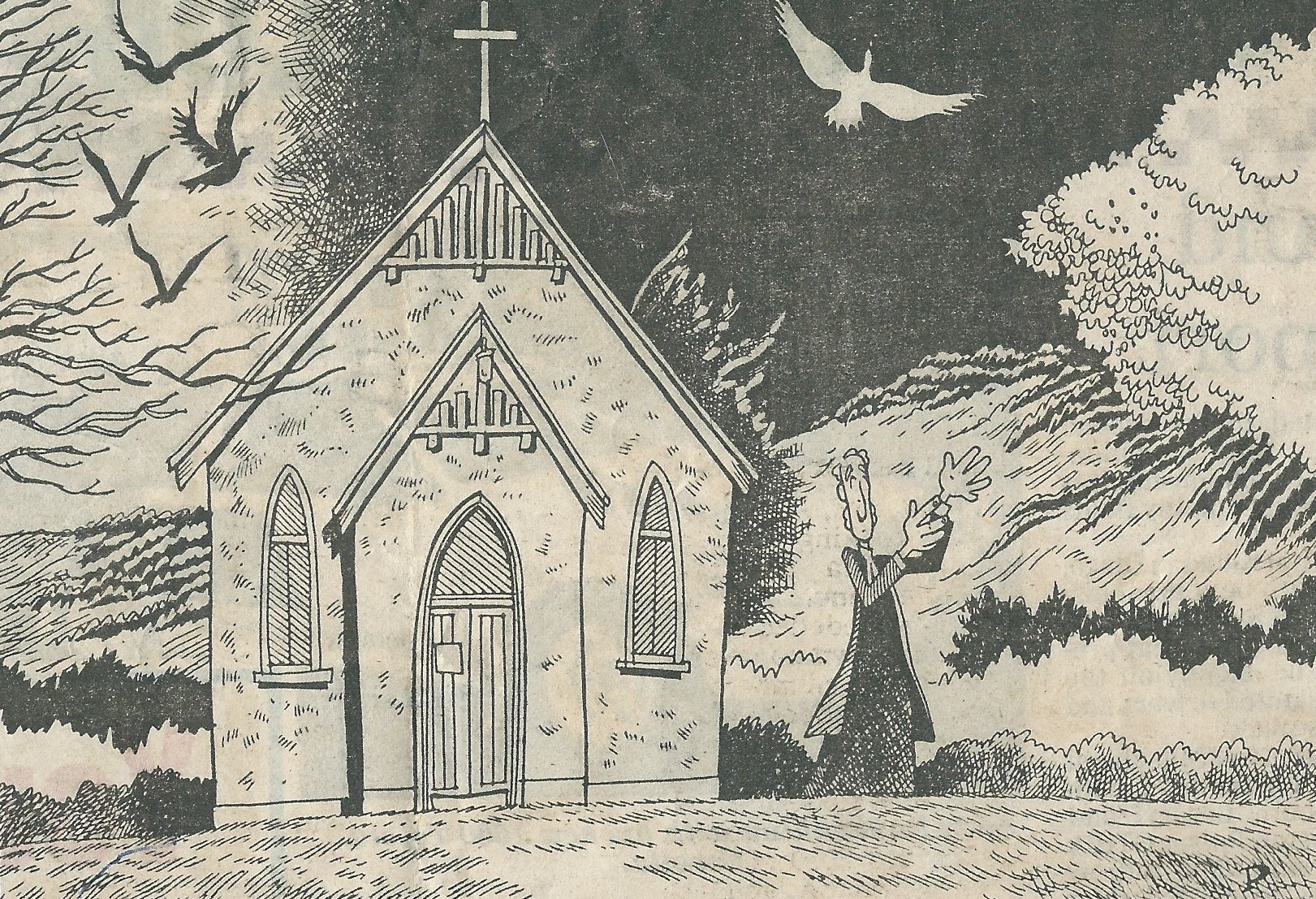
Allanton Church, Peter McLauchlan’s sketchbook, Star Midweek, 19 June 1996, p 18
“Peter McLauchlan’s Sketchbook, with Bill Brosnan. They helped build Otago. A popular television series recalled the day of top Dunedin lawyer A. C. Hanlon. One episode sprang from bygone tragedy in the hamlet of Allanton (formerly known as Greytown). For some viewers, the Otokia region made a familiar backdrop. Key settlers here in 1850 were the Allan of Hopehill Estate whose farming enterprise generated work. Eleven years later gold rush trade saw further development.
Meanwhile in Europe, coal and steam furnished brad for the masses… a downcast peasantry were among those to profit. Migrant labour in America or the Dominions also counted… “Paddy on the railway” was flesh and blood! Like much of small-town New Zealand, Greytown had its hour at the coming of rail, Sir Julius Vogel’s public works agenda of the 1870s as major catalyst.
Drawn by the Vogel scheme, come 1872 a band of Polish families-in-exile reached Otago (via Hamburg and the good ship Palmerston). For men of the group, farm billets would prove elusive, but opportunity rose driving the railhead south over Taieri swampland. With nights faced under canvas at first, theirs was no easy lot. Happily, the calm endurance of Slavic nature made itself apparent and tough assignments were put behind. Personal betterment as roadman or farmer became available as time went by. When the Poles’ railway contract neared an end in 1875 search began for a permanent abode. As chance had it, their late riverside home-place met criteria. Blocks were offered by Government on fair terms… a rail station built and name bestowed honouring Sir George Grey.
From what has been told of the ensuing village, an image resides of clay and wattle houses – their walled gardens a colourful riot, an industrious yet fun-loving people, open fires and corrugated iron. Most allotments ran both cow and pig. Beehives were tended and cottage goodies made. Though Poles were not a majority in the district, song, dance and an allied faith widened local horizons. Did they brew moonshine in those hills? Wedding, birth or funeral could bring an almighty dust-up… much to the alarm of decent wives, grimly restraining their hefty fellows! When anyone lay dying a white dove was given its freedom, signifying a soul’s heavenly ascent.
Devout Catholics of the area rejoiced when Bishop Moran opened the Sacred Heart Church in 1888 (kin at Waihola got their own church a decade later). Another milestone was the name change to Allanton in 1895. ending confusion with a North Island centre and remembering the pioneer Allan family. As the years passed modern housing replaced the old. Many Poles went farming in their own right or found more lucrative employemnt. Of the original stock, only the Gorinskis remain at Allanton. (Frank was my railway gaffer in the 1960s).
Fear not, however. A young wisnesky plays rugby for Taieri, emulating the valiant Laurence Kovaleski! And should you meet a nubile maiden, versed in arts like sewing, cookery and music bearing a surname that ends with “ski” … speak no ill of the Allanton Poles!
Postscripts: Thanks to the Gorisnki family and J.W. Pobog-Jawarowski, who made this narrative possible.” Star Midweek, 19 June 1996, p 18
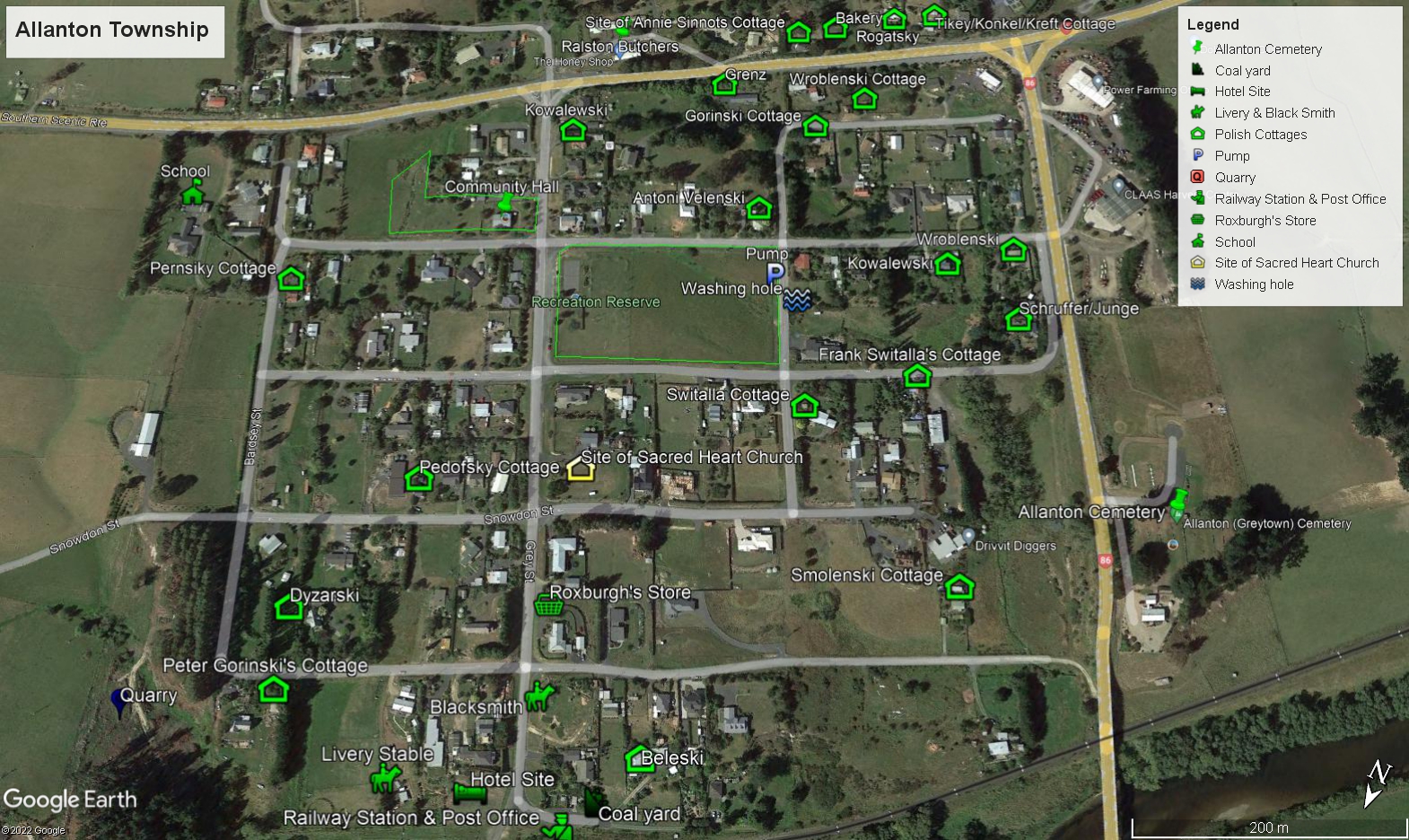
Location of Polish families in Allanton, courtesy of Herbert Irving Turnbull’s map of Allanton 1910 & Google Earth
Polish names associated with early Allanton are:- Bielicki (Belesky), Chajewski (Hieffskie), Tysarczyk (Dysarski), Gurzinski (Gorinski), Greca (Grants), Junge (Young), Klas (Klass), Kąkel (Konckel), Kowalewski (Kovalevski), Kreft, Pędowski (Pedofsky), Piernicki (Perniskie), Rogacki (Rogatski), Smoliński (Smolenski), Świtalla, Teike (Tikey), Trąpski (Tropsky), Waliński (Velenski) & Wróblewski (Wroblefski).
[i] “The Bruce Herald”, 28th March 1873.
[ii] “The Bruce Herald”, 23rd December 1873.
[iii] “The Bruce Herald”, 17th February 1874
[iv] “The Bruce Herald”, 2nd– 20th October 1874.
[v] “The Bruce Herald”, 11th April 1876.
[vi] “A Study Of The Polish Settlement At Greytown”, Michele Poole
[vii] “A Study Of The Polish Settlement At Greytown”, Michele Poole
Compiled by Paul Klemick (2024)
